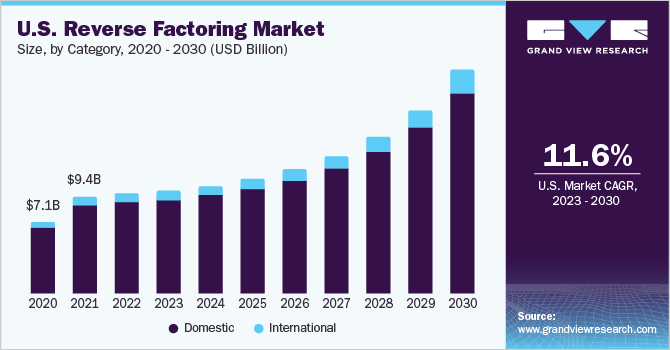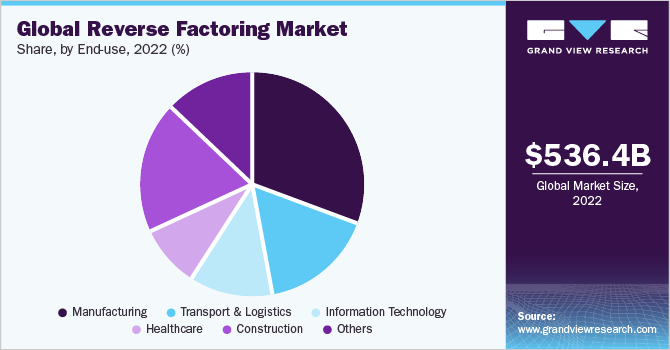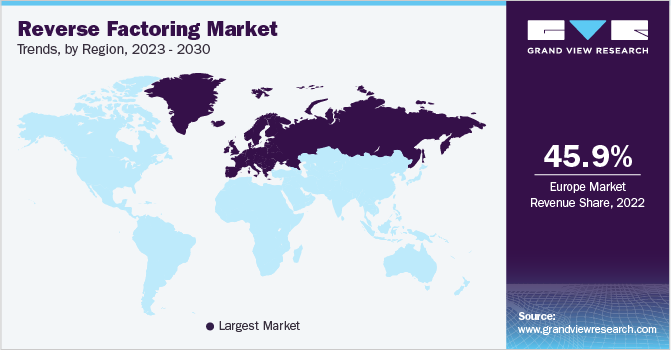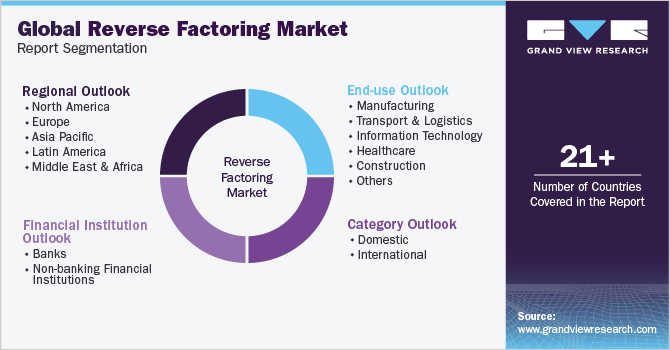- Home
- »
- IT Services & Applications
- »
-
Reverse Factoring Market Size, Share & Trends Report, 2030GVR Report cover
![Reverse Factoring Market Size, Share & Trends Report]()
Reverse Factoring Market Size, Share & Trends Analysis Report By Category (Domestic, International), By Financial Institution (Banks, Non-banking Financial Institutions), By End-use, By Region, And Segment Forecasts, 2023 - 2030
- Report ID: GVR-4-68040-066-4
- Number of Report Pages: 130
- Format: PDF, Horizon Databook
- Historical Range: 2018 - 2021
- Forecast Period: 2023 - 2030
- Industry: Technology
Report Overview
The global reverse factoring market size was evaluated at USD 536.43 billion in 2022 and is expected to grow at a compound annual growth rate (CAGR) of 11.4% from 2023 to 2030. The damaging market integrity, losing investor confidence, and insider business pressure on financial institutions to aggressively invest in supply chain finance solutions and services are driving the growth of the reverse factoring or supply chain finance (SCF) market. Financial institutions are increasingly investing in SCF solutions to compete in this untapped market opportunity. For instance, in November 2021, Citi, a financial service corporation, launched Citi Supplier Finance, a web-based solution to help organizations realize an uninterrupted supply flow and support the working capital of the suppliers.

Reverse factoring provides financial security in the form of payment risk and supply risk to an exporter and importer, supporting the demand for SCF services. Reverse factoring has advanced to address all these issues by accelerating payments to exporters and importers and assuring all importers that all goods ordered with a Line of Credit (LOC) have been shipped, creating a favorable environment for the supply chain financing market.
The increasing investments by Micro, small medium manufacturing enterprises (MSMEs) in reverse factoring tools for pre-trade, post-trade, and examination of cross-asset and cross-market goods are driving the growth of the reverse factoring industry. Furthermore, MSMEs face a shortage of inventory, delayed payments to suppliers, and delays in technology adoption.
These issues are recurrent in developing countries due to limited access to finance owing to remarkable micro-level barriers, such as lack of collaterals and asymmetric information, and macro-level barriers, such as volatile capital availability and ineffective banking services. To address these issues, SCF reduces suppliers' credit, default, or payment risks with financial institutions and provides better security, ensuring that SMEs can fulfill larger orders and accelerating the demand for diverse factoring services. Furthermore, SCF optimizes the working capital flow within the entire supply chain and enhances the relations between buyers and suppliers, boosting the supply chain financing market growth.
The growing awareness about the benefits of reverse factoring services is encouraging industry stakeholders such as governments, associations, and key players to augment the serviceability of SCF services globally. For instance, in May 2020, Citi, an investment banking and financial service provider, launched a web-based supply chain platform for 14 countries in Latin America.
The countries include Argentina, Brazil, Mexico, Colombia, Peru, Dominican Republic, Puerto Rico, Costa Rica, El Salvador, Guatemala, Panama, Honduras, Trinidad, and Jamaica. The platform was designed for tracking, discounting, and reporting receivables and facilitated communication between buyers and sellers, accelerating the market growth.
The global representative body of factoring companies, Factors Chain International (FCI), is also taking various initiatives to improve and promote reverse factoring, such as the launch of a learning course through its e-learning platform to educate students in Supply Chain Financing or reverse factoring. For instance, in November 2021, FCI launched a reverse factoring and supply chain finance course through its learning platform, FCI Academy.
The course aims to educate businesses on reducing supply chain risks, enhancing working capital, and establishing strong liaisons with suppliers. The course comprises questionnaires, case studies, interactive tools, and explanatory videos to enrich the students' experience and test their knowledge, creating robust opportunities for the expansion of the supply chain financing industry.
Advancements in emerging technologies such as natural language processing (NLP), cloud computing, artificial intelligence (AI), big data analytics, the Internet of Things (IoT), and Blockchain are creating robust market opportunities for the reverse factoring industry. Furthermore, the rising usage of e-invoicing systems in various countries such as Mexico, China, India, Peru, and South Korea has played a vital role in the rise of SCF services and open account trade.
Financial institutions rely on digital platforms and fintech to provide clients with risk mitigation and finance solutions. With digital technologies integrated into digital platforms, financial institutions can improve supplier onboarding, supervising functions, regulatory compliances, and other servicing functions, supporting the supply chain financing market growth. This assists financial institutions in risk control and offering reverse factoring services at a lower cost.
Category Insights
The domestic segment accounted for the largest market share of 92.7% in 2022. The segment growth can be attributed to the increasing adoption of SCF services among domestic MSMEs due to its effectiveness. Most of the suppliers across the globe are Micro, Small & Medium-sized Enterprises (MSMEs). Delayed payments from the buyers make it difficult for suppliers to ensure consistent production cycles.
The issue is further aggravated as the suppliers have no alternate finance access, affecting their overall business operations. To overcome these issues, MSMEs are now adopting reverse factoring to optimize their inventory stock and prevent business loss due to finance scarcity.
The international segment is anticipated to grow at a CAGR of 14.4% during the forecast period. The international segment is expected to witness significant growth owing to the rising demand for open trade accounts, especially from suppliers in emerging countries. International reverse factoring services are a requisite for organizations engaging in international trade, irrespective of their current industry and size.
Apart from lowering the credit risk, international reverse factoring offers numerous other benefits, such as easy availability of information on current and prospective clients, expansion into foreign markets, less documentation, improved working capital, overcoming issues related to foreign customs, supporting the growth of the international reverse factoring industry.
Financial Institution Insights
The bank segment accounted for a market share of 81.8% in 2022. The growth can be attributed to the rising popularity of digitalization to fill the current gaps in various financial services and shifting various banks' focus on offering enhanced consumer experience.
Increasing cross-border transactions and significant adoption of mobile-based payment systems is expected to propel the growth of the bank segment over the forecast period. Moreover, the growing use of Blockchain technology by banks to address constraints in raising working capital and cash flows is boosting the proliferation of reverse factoring services in banks.
The Non-Banking Financial Institutions (NBFIs) segment is expected to grow at the highest CAGR of 13.0% during the forecast period. The NBFIs offers improved transparency & flexibility in their reverse factoring solutions and helps various businesses in dealing with evolving supply chain and geopolitical environment, creating robust opportunities for the reverse factoring industry.
NBFIs provide trade expertise with the use of digital solutions to improve the trade of their domestic and international clients. Furthermore, NBFIs are adopting emerging technologies such as AI, ML, and data analytics to overcome various challenges in credit & deposit systems, asset management, & lending and provide several services, including alternative credit model and regulatory compliance, supporting segment growth in the supply chain financing market.
End-use Insights
The manufacturing segment accounted for the largest market share of 30.7% in 2022. Reverse factoring improves cash flow by providing suppliers with the option of receiving early invoice payments andextending a manufacturer's supplier payment terms. Reverse factoring services are used by manufacturing companies across various sectors, such as chemical, metal & machinery, welding, pallet, and plastics & polymers, creating a positive market outlook for supply chain financing services.
Furthermore, reverse factoring allows manufacturing companies to keep multiple relations with banks and an opportunity to provide liquidity. Moreover, it also enables manufacturing companies a better visibility in invoice status and payment processing which allows them to know the payment date, which mitigates the risk of disrupting the relationship with the supplier, creating a positive outlook for the supply chain financing market.

The healthcare segment is expected to grow at the highest CAGR of 13.9% during the forecast period. Manufacturers in the healthcare sector are taking various initiatives to expand their business operations. However, these initiatives are expensive and require frequent funding. When healthcare companies face issues in business expansion, reverse factoring can help them bring desired changes to the business models and expand their business operations.
Furthermore, reverse factoring also helps to improve the company’s cash position. The improved cash position encourages the company to invest in R&D operations to enhance its product portfolio and market position, creating a favorable environment for the reverse factoring industry in the healthcare sector.
Regional Insights
Europe held a significant share of 60.1% of the target market in 2022. The significant growth of the Europe reverse factoring market can be attributed to increasing business activity levels, availability of quick expert advice for financial management from a majority of the firms, and significant penetration of the market leaders in the region. Supportive government initiatives to assist start-ups in raising public & private funding and focus on established reverse factoring service providers on offering alternative financial assistance by buying SMEs’ pending invoices are creating a positive market outlook in Europe.
Latin America is anticipated to grow as the fastest-developing regional market at a CAGR of 18.0% through 2030. The growth of Latin America's reverse factoring industry can be attributed to the shift in focus of companies from various sectors on bad debt evasion and business growth with better financial stability. Several Latin American countries, such as Argentina, Peru, Chile, Mexico, and Brazil, are witnessing rising demand for reverse factoring services in most sectors.

Furthermore, domestic and international factoring services are used to offer exporters easy access to funds by transforming discounted receivables of the company into improved cash flows. Increasing F&B industry and staffing agencies penetration in the region is creating a positive market outlook for multiple financing solutions, creating robust opportunities for the reverse factoring industry.
Key Companies & Market Share Insights
The key players include Accion International; Barclays plc; Deutsche Factoring Bank; TRADEWIND GMBH; and JP Morgan Chase & Co. to broaden their product offering, companies utilize a variety of inorganic growth tactics, such as partnerships, regular mergers, and acquisitions.
In October 2022, HSBC Hongkong, a wholly-owned subsidiary of HSBC Group, launched Trade Platform, a one-stop e-platform that provides a flexible, safe, and secure offering for managing global transactions of trade loans for sellers and buyers, guarantees, import Bills, and import documents for credit. With reduced paperwork, time-saving, and real-time status tracking. The company aims at is to offer all trade services with this digital platform to the customers. Some prominent players in the global reverse factoring market include:
-
Accion International
-
Banco Bilbao Vizcaya Argentaria, S.A.
-
Barclays Plc
-
Credit Suisse Group AG
-
Deutsche Factoring Bank
-
Drip Capital Inc.
-
eFactor Network
-
HSBC Group
-
JP Morgan Chase & Co.
-
Mitsubishi UFJ Financial Group, Inc.
-
PrimeRevenue, Inc.
-
Societe Generale
-
Trade Finance Global
-
TRADEWIND GMBH
-
Viva Capital Funding, LLC
Recent Development
- In December 2022, Endesa along with Banco Bilbao Vizcaya Argentaria, Caixabank, and Santander launched the circular reverse factoring solution which provides bonuses, and rewarding sustainable practices. This launch helped them to increase their competitiveness in the economy
Reverse Factoring Market Report Scope
Report Attribute
Details
Market size value in 2023
USD 555.21 billion
Factoring volume forecast in 2030
USD 1,179.32 billion
Growth rate
CAGR of 11.4% from 2023 to 2030
Base year for estimation
2022
Historical data
2018 - 2021
Forecast period
2023 - 2030
Quantitative units
Factoring volume in USD billion and CAGR from 2023 to 2030
Report coverage
Factoring volume forecast, company market share, competitive landscape, growth factors, and trends
Segments covered
Category, financial institution, end-use, region
Regional scope
North America, Europe, Asia Pacific, Latin America, Middle East & Africa
Country scope
U.S.; Canada; Germany; UK; France; Italy; Spain; China; India; Japan; South Korea; Australia; Brazil; Mexico; Chile; Peru; Argentina; Paraguay; Uruguay; Ecuador; Colombia; Bolivia; U.A.E.; Saudi Arabia; South Africa
Key companies profiled
Accion International; Banco Bilbao Vizcaya Argentaria, S.A.; Barclays Plc; Credit Suisse Group AG; Deutsche Factoring Bank; Drip Capital Inc.; eFactor Network; HSBC Group; JP Morgan Chase & Co.; Mitsubishi UFJ Financial Group, Inc.; PrimeRevenue, Inc.; Societe Generale; Trade Finance Global; TRADEWIND GMBH; Viva Capital Funding, LLC
Customization scope
Free report customization (equivalent up to 8 analysts working days) with purchase. Addition or alteration to country, regional & segment scope.
Pricing and purchase options
Avail customized purchase options to meet your exact research needs. Explore purchase options
Global Reverse Factoring Market Report Segmentation
This report forecasts revenue growth at global, regional, and country levels and provides an analysis of the latest industry trends in each of the sub-segments from 2018 to 2030. For this study, Grand View Research has segmented the global reverse factoring market report based on category, financial institution, end-use, and region:

-
Category Outlook (Factoring Volume, USD Billion, 2018 - 2030)
-
Domestic
-
International
-
-
Financial Institution Outlook (Factoring Volume, USD Billion, 2018 - 2030)
-
Banks
-
Non-banking Financial Institutions
-
-
End-use Outlook (Factoring Volume, USD Billion, 2018 - 2030)
-
Manufacturing
-
Transport & Logistics
-
Information Technology
-
Healthcare
-
Construction
-
Others (Retail, Food & Beverages, Among Others)
-
-
Regional Outlook (Factoring Volume, USD Billion, 2018 - 2030)
-
North America
-
U.S.
-
Canada
-
-
Europe
-
Germany
-
UK
-
France
-
Italy
-
Spain
-
-
Asia Pacific
-
China
-
India
-
Japan
-
South Korea
-
Australia
-
-
Latin America
-
Brazil
-
Mexico
-
Chile
-
Peru
-
Argentina
-
Paraguay
-
Uruguay
-
Ecuador
-
Colombia
-
Bolivia
-
-
Middle East & Africa
-
U.A.E
-
Saudi Arabia
-
South Africa
-
-
Frequently Asked Questions About This Report
b. The global reverse factoring market is expected to grow at a compound annual growth rate of 11.4% from 2023 to 2030 to reach USD 1,179.32 billion by 2030.
b. Europe held a significant share of 60.1% of the market in 2022. The significant growth of the Europe reverse factoring market can be attributed to increasing business activity levels, availability of quick expert advice for financial management from a majority of the firms, and significant penetration of the market leaders in the region.
b. The global reverse factoring market size was estimated at USD 536.43 billion in 2022 and is expected to reach USD 1,179.32 billion in 2023.
b. Some key players operating in the reverse factoring market include Accion International; Banco Bilbao Vizcaya Argentaria, S.A.; Barclays Plc; Credit Suisse Group AG Deutsche Factoring Bank; Drip Capital Inc.; eFactor Network; HSBC Group; JP Morgan Chase & Co.; Mitsubishi UFJ Financial Group, Inc.; PrimeRevenue, Inc.; Societe Generale; Trade Finance Global; TRADEWIND GMBH; and Viva Capital Funding, LLC.
b. The increasing investments by Micro, Small Medium Manufacturing Enterprises (MSMEs) in reverse factoring tools for pre-trade, post-trade, and examination of cross-asset and cross-market goods are driving the growth of the reverse factoring market.
Share this report with your colleague or friend.
![gvr icn]()
NEED A CUSTOM REPORT?
We can customize every report - free of charge - including purchasing stand-alone sections or country-level reports, as well as offer affordable discounts for start-ups & universities. Contact us now
![Certified Icon]()
We are GDPR and CCPA compliant! Your transaction & personal information is safe and secure. For more details, please read our privacy policy.
We are committed towards customer satisfaction, and quality service.
"The quality of research they have done for us has been excellent."





